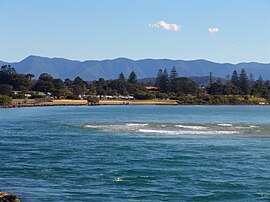world.wikisort.org - Australia
Urunga is a small town located within the Mid North Coast region of New South Wales, Australia, in Bellingen Shire. It is famous for its surf spots (reefs, beaches and mouth of two rivers). At the 2011 census, Urunga had a population of 3,020.[2] The town is south of Coffs Harbour and Sawtell and north of Nambucca Heads. The place name, Urunga (pronounced Yoo-run-ga), is derived from the Gumbaynggir word Yurūnga (pronounced Yu-roon-ga), which is derived from the word for long yurūn[3] in reference to "long white sands".[4]
| Urunga New South Wales | |
|---|---|
 Urunga | |
 Urunga | |
| Coordinates | 30°30′0″S 153°01′0″E |
| Population | 3,000 (2016 census)[1] |
| Postcode(s) | 2455 |
| Elevation | 7 m (23 ft) |
| Location |
|
| LGA(s) | Bellingen Shire |
| State electorate(s) | Oxley |
| Federal division(s) | Cowper |
Geography
There are two main streets, and both a bowling club and a golf club. A weekly 6-a-side soccer competition is held on Thursdays at the Oval on Morgo Street, colloquially known as the Cabbage Patch or simply 'The Patch'.[citation needed]
History
Urunga is a fishing ground, with bream being the main sport fish.[citation needed] The Urunga boardwalk, leading over the tidal Urunga Lagoon then out to the beach, was rebuilt in 1988 and extended in 1991. The full boardwalk was completed in 2007. In November 2010, a further section of boardwalk was completed. This extension finishes at the mouth of the river and has taken the length of the boardwalk to almost one kilometre (0.62 mi). Hungry Head, four kilometres (2.5 mi) to the south is the only patrolled beach in Urunga.[5]
On 8 December 2017, the Federal Court of Australia determined that the Gumbaynggirr People have native title rights and interests over an area of land and waters at Wenonah Head, near Urunga. This determination resolved the oldest native title claim in New South Wales.[6]
Culture
Urunga celebrates Father's Day with a "Picnic in the Park" in September and a Flathead fishing comp in November.
Education
Transport
Urunga railway station opened on the North Coast line in 1923 and continues to be served by country passenger trains.[7]
Urunga Wetlands
In May 2017 the Urunga Wetlands were opened to the public. It features a wheelchair accessible 150-metre boardwalk and a 450-metre walking track surrounding the park.[8] In the late 1960s and early 1970s the area was the site of a processing plant used for extracting the heavy metal antimony from its ore, stibnite. Antimony and other heavy metals leached into the surrounding melaleuca wetlands creating what was claimed to be "one of the most polluted natural environments in New South Wales."[9] In 2015 a $10 million reclamation project began that involved treating over 36,000 tonnes of contaminated soils at the site and its storage in an onsite containment cell. Water quality of the wetlands has returned to acceptable levels and birds and other wildlife have started to return since completion of the project.[10]
Gallery
References
- Australian Bureau of Statistics (27 June 2017). "Urunga (State Suburb)". 2016 Census QuickStats. Retrieved 4 February 2018.
- Australian Bureau of Statistics (31 October 2012). "Urunga (State Suburb)". 2011 Census QuickStats. Retrieved 16 November 2014.
- Eades, D. 'Gumbayngir' Handbook of Australian Languages Volume 1, 1979
- "Urunga". Geographical Names Register (GNR) of NSW. Geographical Names Board of New South Wales. Retrieved 11 August 2013.
- "Hungry Head - Beach in Urunga Bellingen NSW". SLS Beachsafe. Retrieved 31 December 2020.
- "Gumbaynggirr-People-native-title-determination-fact-sheet" (PDF).
- Urunga station. NSWrail.net, accessed 26 August 2009.
- Department of Industry, NSW Government (2017). "Fact sheet: Urunga Wetlands" (PDF). Retrieved 19 October 2019.
- Cornish, Ruby (2 May 2017). "Poisoned wetlands transformed into eco-friendly attraction in northern NSW". Australia: ABC News. Retrieved 19 October 2019.
- Bellingen Shire Council (8 May 2017). "Urunga Wetlands Walk Now Open". bellingen.nsw.gov.au. Retrieved 19 October 2019.
External links
Другой контент может иметь иную лицензию. Перед использованием материалов сайта WikiSort.org внимательно изучите правила лицензирования конкретных элементов наполнения сайта.
WikiSort.org - проект по пересортировке и дополнению контента Википедии



